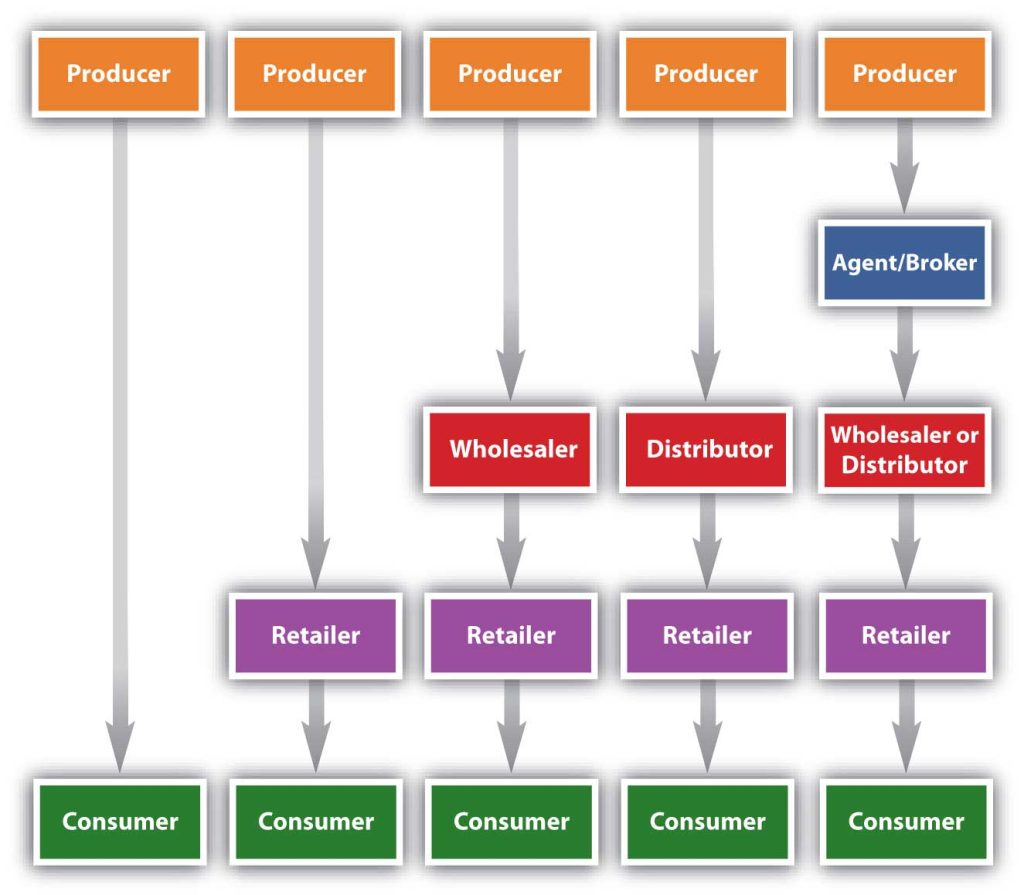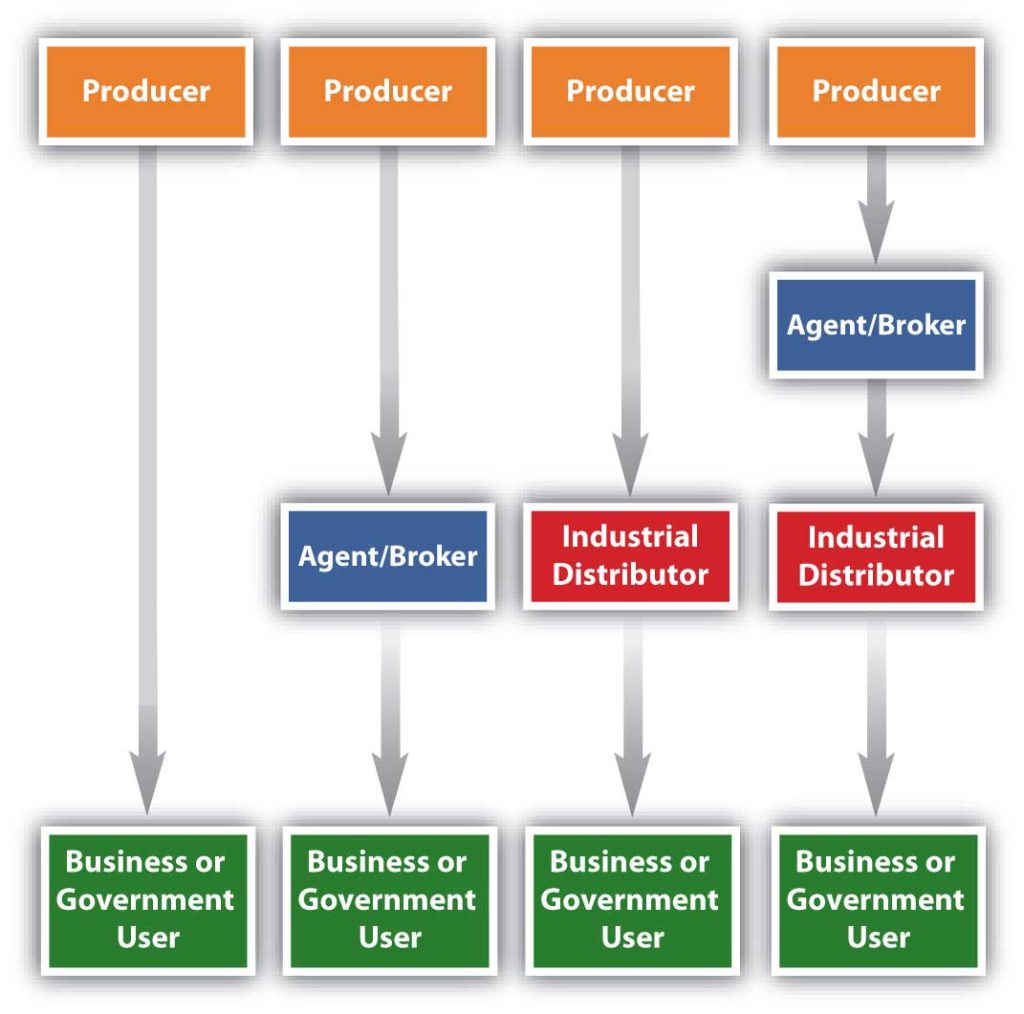9.2 Channel Types
With such a variety of products, services, and target markets that exist in the world economy, there is no such thing as a ‘one size fits all’ approach to channel management. In this section and the following, we will look at how to design a channel. This section begins by examining channel structure options and types.
Consumer Channels compared to B2B Channels
Figure 9.2.1 “Typical Channels in Business-to-Consumer (B2C) Markets” shows the typical channels in business-to-consumer (B2C) markets. As we explained, the shortest marketing channel consists of just two parties—a producer and a consumer. A channel such as this is called a direct channel. By contrast, a channel that includes one or more intermediaries—say, a wholesaler, distributor, or broker or agent—is an indirect channel. In an indirect channel, the product passes through one or more intermediaries. That doesn’t mean the producer will do no marketing directly to consumers. Levi’s runs ads on TV and on social media, designed to appeal directly to consumers. The makers of food products run coupon ads. However, the seller also has to focus its selling efforts on these intermediaries because the intermediary can help with the selling effort. Not everyone wants to buy Levi’s online. As the graphic illustrates, the channel begins with the producer who sells to any combination of consumer, agent/broker, distributor, retailer with the consumer being the ultimate end user.
Figure 9.2.1: Typical Channels in Business-to-Consumer (B2C) Markets

Figure 9.2.2 “Typical Channels in Business-to-Business (B2B) Markets” shows the marketing channels common in business-to-business (B2B) markets. Notice how the channels resemble those in B2C markets, except that the products are sold to businesses and governments instead of consumers like you.
Figure 9.2.2: Typical Channels in Business-to-Business (B2B) Markets

Direct Channels
Direct channels occur when the producer of the product sells and distributes directly to the end user of the product. Direct channels are seen in both B2B and B2C situations. Services are a common example of a direct channel. If a business, or a consumer, hires someone to prepare their taxes, that is a direct channel as the provider of the service deals directly with the end user. In terms of tangible goods, direct channels are more common in B2B situations as the buyers wish to negotiate, buy large quantities, and have special demands. There are inefficiencies at times, as the producer has to perform all the functions that intermediaries might have performed.
Indirect Channels
By contrast, an indirect marketing channel is a channel that has intermediaries.
Most indirect channels can be classified as a conventional marketing system in which the channel members have no affiliation with one another. All the members operate independently. If the sale or the purchase of a product seems like a good deal at the time, an organization pursues it. But there is no expectation among the channel members that they have to work with one another in the future. However, most firms work toward building long-term relationships with their channel partners.
If the indirect channel is not a conventional marketing system, then it is considered to be a vertical marketing system.
Vertical Marketing Systems (VMS)
Another way to foster cooperation in a channel is to establish a vertical marketing system. In a vertical marketing system, channel members coordinate activities and planning with one another. The do this to maximize efficiencies and to establish long-term working relationships, thus eliminating the time and cost of searching for new channel members.
There are three main types of VMSs: corporate VMS, administered VMS, and contractual VMS.
A corporate VMS occurs when channel members are owned by one channel member or a parent company. Occasionally, this occurs through a form of disintermediation (decreasing the number of intermediaries) known as vertical integration, where one channel member takes over the functions of another member.
An administered VMS is difficult to identify from the outsider’s view. Technically, this arrangement is a conventional channel but the members have informal agreements to foster a long-term relationship. They will share planning, forecasting, strategy and inventory information regularly to coordinate the activities effectively. This shared decision making is a key aspect of an administered VMS.
Franchises are another type of vertical marketing system, called a contractual VMS. They are used not only to lessen channel conflicts but also to penetrate markets. Recall that a franchise gives a person or group the right to market a company’s goods or services within a certain territory or location. McDonald’s sells meat, bread, ice cream, and other products to its franchises, along with the right to own and operate the stores. And each of the owners of the stores signs a contract with McDonald’s agreeing to do business in a certain way.
Conclusion
As we look at these different types of channel, it is important to note that there are many versions and hybrids of these structures. Many organizations will use multiple channels including direct, franchises and a conventional channel to reach their intended target market. The structures discussed here are the basic foundations. Creativity is encouraged in the formation of the structure as long as efficiencies are provided and needs are met. This will be discussed in more specific detail in the next section.

